The next decade promises revolutionary advancements in space technology. From upcoming space missions to breakthroughs in reusable rockets and the expansion of private space enterprises, the space industry is poised to impact telecommunications, Earth monitoring, and even space tourism. This blog explores the future of space technology and the potential changes it could bring to life on Earth.
1. Upcoming Space Missions: Aiming for the Stars
Space agencies and private companies worldwide have planned ambitious missions, from lunar exploration to interplanetary ventures.
- Lunar Missions: NASA’s Artemis program, aiming to return humans to the Moon by 2025, includes plans to establish a sustainable lunar presence by the 2030s. China’s space agency and other nations have lunar exploration plans as well. A permanent lunar base could serve as a launch point for missions to Mars and beyond.
- Mars Exploration: NASA, SpaceX, and international agencies are actively pursuing Mars missions. SpaceX’s Starship system is designed to make interplanetary travel feasible, with the ambitious goal of landing humans on Mars. Learn more about Mars exploration and its potential impact on humanity (internal link).
- Interplanetary Missions: Upcoming missions like the European Space Agency’s (ESA) JUICE, set to explore Jupiter’s moons, and NASA’s Dragonfly, a drone bound for Saturn’s moon Titan, showcase the growing focus on studying other worlds. These missions aim to uncover insights about the solar system and the possibility of extraterrestrial life.
2. Reusable Rocket Technology: Paving the Way for Affordable Space Travel
Reusable rocket technology is a game-changer, lowering the cost of space access and opening doors for new players in the space industry.
- SpaceX Falcon 9 and Starship: SpaceX revolutionized the industry with the Falcon 9 rocket, the first reusable rocket to land back on Earth. The Starship rocket, which SpaceX plans to use for deep-space missions, is designed to be fully reusable, making space exploration more sustainable and cost-effective.
- Blue Origin’s New Shepard and New Glenn: Jeff Bezos’s Blue Origin has also invested in reusable technology. Their New Shepard rocket is designed for suborbital space tourism, and New Glenn, a larger, reusable orbital rocket, aims to serve commercial satellite launches.
- Impact on Costs and Sustainability: Reusability drastically reduces launch costs, enabling more frequent missions and allowing emerging economies to participate in space endeavors. This shift promotes sustainability and aligns with environmental considerations as the industry seeks greener solutions. Explore the sustainability initiatives in space technology (internal link).
3. The Rise of Private Space Companies: Expanding Horizons
Private companies are taking on a greater role in space exploration, and their innovations are transforming the industry landscape.
- SpaceX and Blue Origin: These companies have led the way in commercializing space travel. With reusable rockets, satellite networks like Starlink, and ambitious planetary missions, SpaceX is pushing boundaries. Blue Origin focuses on space tourism and lunar projects in collaboration with NASA.
- Rocket Lab: New Zealand-based Rocket Lab specializes in launching small payloads with its Electron rocket, making space access affordable for smaller entities. Their Photon satellite platform aims to support deep-space missions, including a planned mission to Venus.
- Smaller Startups and the Democratization of Space: Companies like Relativity Space, which is 3D-printing entire rockets, and smaller satellite startups are enabling more players to enter space. The democratization of space access could mean more research, rapid technological advancement, and broader applications across industries.
4. Telecommunications and Global Connectivity: Satellite Networks
Telecommunications advancements are closely tied to space technology, especially with the rise of satellite constellations that enable global internet coverage.
- Low Earth Orbit (LEO) Satellites: Satellite constellations like SpaceX’s Starlink, Amazon’s Project Kuiper, and OneWeb aim to provide fast, affordable internet worldwide. These LEO satellites offer lower latency than traditional geostationary satellites, improving connectivity for remote areas.
- 5G and Beyond: Satellites play a crucial role in expanding 5G coverage and could even contribute to the development of 6G networks. Improved connectivity enables advancements in fields like telemedicine, remote education, and global commerce. Read about 5G vs. 6G advancements (internal link).
- Emerging Markets and Remote Areas: The ability to connect the most remote parts of the world opens new economic opportunities. Increased access to internet services, education, and healthcare could bridge the digital divide, bringing equal opportunities to underserved regions.
5. Earth Monitoring and Climate Research: Satellites for a Sustainable Planet
Space-based technologies play a vital role in monitoring Earth’s environment, with significant benefits for climate research and disaster management.
- Earth Observation Satellites: Satellites provide critical data on climate change, tracking deforestation, air pollution, melting glaciers, and rising sea levels. Programs like ESA’s Copernicus and NASA’s Earth Observing System contribute to our understanding of environmental changes. NASA Earth Science Division (external link).
- Natural Disaster Response: Real-time data from satellites can support early warning systems for natural disasters like hurricanes, earthquakes, and wildfires. This information can help authorities prepare and respond effectively, potentially saving lives and reducing property damage.
- Agricultural and Water Resource Management: Satellites also enable precision agriculture, helping farmers monitor crop health and manage resources like water and soil nutrients efficiently. The use of satellite technology in agriculture can enhance food security and support sustainability efforts.
6. Space Tourism: The Final Frontier for Adventure
Space tourism, once a distant dream, is now on the brink of reality as companies develop space travel options for civilians.
- Suborbital Flights: Blue Origin’s New Shepard and Virgin Galactic’s SpaceShipTwo offer suborbital flights, allowing tourists to experience a few minutes of weightlessness and see Earth from space. These flights are the first step towards accessible space tourism.
- Orbital and Lunar Tourism: SpaceX is planning orbital trips around the Moon for private customers, with their Starship rocket designed to carry tourists on lunar flyby missions. This concept has attracted attention from wealthy individuals seeking unique space experiences. Read about upcoming space tourism trends (internal link).
- The Long-Term Potential of Space Tourism: As technology improves and costs decrease, space tourism could become more accessible, with space hotels and extended trips. This new industry could also spark interest in space exploration and innovation.
Conclusion
The next decade in space technology is set to transform our world. From ambitious missions to Mars to reusable rockets and the rise of private companies, advancements in space technology will impact various aspects of our lives. Telecommunications, Earth monitoring, and space tourism are just a few of the sectors that stand to benefit from these innovations.
As we look to the future, it’s clear that space technology will continue to push boundaries and unlock new possibilities. The dreams of interplanetary travel, sustainable Earth monitoring, and connecting the most remote areas on our planet are within reach, heralding an era of exploration and innovation.
By incorporating internal links to relevant topics on epicinfinite.com and credible external sources, this blog provides readers with a comprehensive overview and additional resources to explore related subjects. Let me know if you need further optimization!










